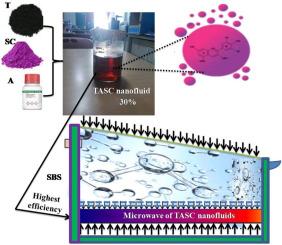微波辐照对太阳蒸馏用MXene-Ag-Syzygium染料纳米流体热物理和储能性能的影响
IF 9.5
Q1 ENERGY & FUELS
引用次数: 0
摘要
该研究深入研究了微波电磁辐射对新型MXene (T) -银(Ag) - Syzygium cumini染料(SC) (Ti₃C₂Tx/Ag/SC - TASC)纳米流体的热物理属性和焓能储存(ΔHes)能力的深刻影响,该纳米流体专门用于提高单斜坡盆地太阳能蒸馏器(SBS)的性能。纳米流体以不同体积浓度(0%(不含TASC), 10%, 20%和30%)精心配制,随后进行精确校准的微波暴露。我们严格表征了微波处理前后TASC纳米流体的热物理性质(导热系数(λ)、比热(Cp)、粘度(µ)、密度(ρ))。这种SC吸收培养得到了改善,电荷分离使结晶紫(0.0199 min-¹时94%)和苯酚(0.0121 min-¹时83.9%)的光催化降解成为可能。微波辐照可显著提高TASC纳米流体的能量储存,增强胶体稳定性和表面形貌。这提高了热导率和比热容,这对于最大化太阳能吸收至关重要。SC作为光敏剂,而TA相互作用,特别是与Ag掺杂,提供优越的热能传导和缓冲。当TASC浓度为30%时,导热系数显著提高7%至9.83%,同时Nusselt数增加29.2%,表明对流换热性能较好。当运动粘度增加23%时,熵产分析证实,温度梯度不可逆性的降低超过了粘性耗散的增加,导致净换热效率为196.63 W/m2⋅K。这些优化的纳米流体具有增强的光热转换和热能保留,直接提高太阳能蒸馏性能。在1.5 cm水深条件下,当TASC浓度为30%时,SBS的日生产力达到5.34 L/m2,显著优于其他浓度(1.70 L/m2)。这种提高的产量源于TASC放大的热能通量,这加速了蒸发。每小时(07:00-18:00)和夜间(18:00-06:00)收集SBS馏分,以最大限度地提高产量。长期试验(2024年9月至2025年1月)证实,30% TASC的平均热效率显著提高52%,而没有TASC的平均热效率为19%。30% TASC的持续高效率凸显了其在可持续海水淡化和水净化方面的巨大潜力。提高光热转换、热保留和蒸发的协同效应大大提高了馏出物产量和整体系统性能,甚至延伸到非日照时间。这项研究通过微波处理为下一代太阳能应用提供了精确的纳米流体工程的重要见解。本文章由计算机程序翻译,如有差异,请以英文原文为准。

Impact of microwave irradiation on the thermophysical and energy storage properties of MXene-Ag-Syzygium cumini dye nanofluids for solar distillation
This investigation delves into the profound influence of microwave electromagnetic radiation on the thermophysical attributes and enthalpic energy storage (ΔHes) capabilities of novel MXene (T) - silver (Ag) - Syzygium cumini dye (SC) (Ti₃C₂Tx/Ag/SC – TASC) nanofluids, specifically engineered for augmenting the performance of single slope basin solar stills (SBS). Nanofluids were meticulously formulated at various volumetric concentrations of with and without TASC (0% (without TASC), 10%, 20%, and 30%) and subsequently subjected to precisely calibrated microwave exposure. We rigorously characterized TASC nanofluid thermophysical properties (thermal conductivity (λ), specific heat (Cp), viscosity (µ), density (ρ)) before and after microwave treatment. This SC absorption foster is improved and charge separation is enabling efficient photocatalytic degradation of crystal violet (94% at 0.0199 min-¹) and phenol (83.9% at 0.0121 min-¹). Microwave irradiation significantly boosts TASC nanofluids energy storage is enhancing colloidal stability and surface morphology. This elevates thermal conductivity and specific heat capacity, crucial for maximizing solar absorption. SC acts as a photosensitizer, while TA interactions, particularly with Ag doping, provide superior thermal energy transduction and buffering. The 30% TASC concentration dramatically improved thermal conductivity by 7% to 9.83%, alongside a 29.2% increase in the Nusselt number, signaling superior convective heat transfer. While kinematic viscosity rose by 23%, an entropy generation analysis confirmed that reduced temperature gradient irreversibility outweighed increased viscous dissipation, leading to a net heat transfer efficiency of 196.63 W/m2⋅K. These optimized nanofluids boast enhanced photothermal conversion and thermal energy retention, directly boosting solar distillation performance. The daily productivity of the SBS, with a 1.5 cm water depth, peaked at 5.34 L/m2 with 30% TASC, significantly outperforming other concentrations (1.70 L/m2 without TASC). This enhanced yield stems from the TASC's amplified thermal energy flux, which accelerates evaporation. SBS distillate was collected hourly (07:00–18:00) and overnight (18:00–06:00) to maximize output. Long-term trials (Sept 2024-Jan 2025) confirmed substantial improvements in average thermal efficiency of 52% with 30% TASC, compared to 19% without TASC. This consistently high efficiency at 30% TASC underscores its immense potential for sustainable desalination and water purification. The synergistic effect of boosted photothermal conversion, thermal retention, and evaporation profoundly enhanced distillate yield and overall system performance, even extending to off-sunshine hours. This research offers crucial insights into precise nanofluid engineering through microwave processing for next-generation solar applications.
求助全文
通过发布文献求助,成功后即可免费获取论文全文。
去求助
来源期刊

Energy nexus
Energy (General), Ecological Modelling, Renewable Energy, Sustainability and the Environment, Water Science and Technology, Agricultural and Biological Sciences (General)
CiteScore
7.70
自引率
0.00%
发文量
0
审稿时长
109 days
 求助内容:
求助内容: 应助结果提醒方式:
应助结果提醒方式:


